
- •Table of Contents
- •Foreword
- •Chapter 1. A Quick Walk Through
- •Workfile: The Basic EViews Document
- •Viewing an individual series
- •Looking at different samples
- •Generating a new series
- •Looking at a pair of series together
- •Estimating your first regression in EViews
- •Saving your work
- •Forecasting
- •What’s Ahead
- •Chapter 2. EViews—Meet Data
- •The Structure of Data and the Structure of a Workfile
- •Creating a New Workfile
- •Deconstructing the Workfile
- •Time to Type
- •Identity Noncrisis
- •Dated Series
- •The Import Business
- •Adding Data To An Existing Workfile—Or, Being Rectangular Doesn’t Mean Being Inflexible
- •Among the Missing
- •Quick Review
- •Appendix: Having A Good Time With Your Date
- •Chapter 3. Getting the Most from Least Squares
- •A First Regression
- •The Really Important Regression Results
- •The Pretty Important (But Not So Important As the Last Section’s) Regression Results
- •A Multiple Regression Is Simple Too
- •Hypothesis Testing
- •Representing
- •What’s Left After You’ve Gotten the Most Out of Least Squares
- •Quick Review
- •Chapter 4. Data—The Transformational Experience
- •Your Basic Elementary Algebra
- •Simple Sample Says
- •Data Types Plain and Fancy
- •Numbers and Letters
- •Can We Have A Date?
- •What Are Your Values?
- •Relative Exotica
- •Quick Review
- •Chapter 5. Picture This!
- •A Simple Soup-To-Nuts Graphing Example
- •A Graphic Description of the Creative Process
- •Picture One Series
- •Group Graphics
- •Let’s Look At This From Another Angle
- •To Summarize
- •Categorical Graphs
- •Togetherness of the Second Sort
- •Quick Review and Look Ahead
- •Chapter 6. Intimacy With Graphic Objects
- •To Freeze Or Not To Freeze Redux
- •A Touch of Text
- •Shady Areas and No-Worry Lines
- •Templates for Success
- •Point Me The Way
- •Your Data Another Sorta Way
- •Give A Graph A Fair Break
- •Options, Options, Options
- •Quick Review?
- •Chapter 7. Look At Your Data
- •Sorting Things Out
- •Describing Series—Just The Facts Please
- •Describing Series—Picturing the Distribution
- •Tests On Series
- •Describing Groups—Just the Facts—Putting It Together
- •Chapter 8. Forecasting
- •Just Push the Forecast Button
- •Theory of Forecasting
- •Dynamic Versus Static Forecasting
- •Sample Forecast Samples
- •Facing the Unknown
- •Forecast Evaluation
- •Forecasting Beneath the Surface
- •Quick Review—Forecasting
- •Chapter 9. Page After Page After Page
- •Pages Are Easy To Reach
- •Creating New Pages
- •Renaming, Deleting, and Saving Pages
- •Multi-Page Workfiles—The Most Basic Motivation
- •Multiple Frequencies—Multiple Pages
- •Links—The Live Connection
- •Unlinking
- •Have A Match?
- •Matching When The Identifiers Are Really Different
- •Contracted Data
- •Expanded Data
- •Having Contractions
- •Two Hints and A GotchYa
- •Quick Review
- •Chapter 10. Prelude to Panel and Pool
- •Pooled or Paneled Population
- •Nuances
- •So What Are the Benefits of Using Pools and Panels?
- •Quick (P)review
- •Chapter 11. Panel—What’s My Line?
- •What’s So Nifty About Panel Data?
- •Setting Up Panel Data
- •Panel Estimation
- •Pretty Panel Pictures
- •More Panel Estimation Techniques
- •One Dimensional Two-Dimensional Panels
- •Fixed Effects With and Without the Social Contrivance of Panel Structure
- •Quick Review—Panel
- •Chapter 12. Everyone Into the Pool
- •Getting Your Feet Wet
- •Playing in the Pool—Data
- •Getting Out of the Pool
- •More Pool Estimation
- •Getting Data In and Out of the Pool
- •Quick Review—Pools
- •Chapter 13. Serial Correlation—Friend or Foe?
- •Visual Checks
- •Testing for Serial Correlation
- •More General Patterns of Serial Correlation
- •Correcting for Serial Correlation
- •Forecasting
- •ARMA and ARIMA Models
- •Quick Review
- •Chapter 14. A Taste of Advanced Estimation
- •Weighted Least Squares
- •Heteroskedasticity
- •Nonlinear Least Squares
- •Generalized Method of Moments
- •Limited Dependent Variables
- •ARCH, etc.
- •Maximum Likelihood—Rolling Your Own
- •System Estimation
- •Vector Autoregressions—VAR
- •Quick Review?
- •Chapter 15. Super Models
- •Your First Homework—Bam, Taken Up A Notch!
- •Looking At Model Solutions
- •More Model Information
- •Your Second Homework
- •Simulating VARs
- •Rich Super Models
- •Quick Review
- •Chapter 16. Get With the Program
- •I Want To Do It Over and Over Again
- •You Want To Have An Argument
- •Program Variables
- •Loopy
- •Other Program Controls
- •A Rolling Example
- •Quick Review
- •Appendix: Sample Programs
- •Chapter 17. Odds and Ends
- •How Much Data Can EViews Handle?
- •How Long Does It Take To Compute An Estimate?
- •Freeze!
- •A Comment On Tables
- •Saving Tables and Almost Tables
- •Saving Graphs and Almost Graphs
- •Unsubtle Redirection
- •Objects and Commands
- •Workfile Backups
- •Updates—A Small Thing
- •Updates—A Big Thing
- •Ready To Take A Break?
- •Help!
- •Odd Ending
- •Chapter 18. Optional Ending
- •Required Options
- •Option-al Recommendations
- •More Detailed Options
- •Window Behavior
- •Font Options
- •Frequency Conversion
- •Alpha Truncation
- •Spreadsheet Defaults
- •Workfile Storage Defaults
- •Estimation Defaults
- •File Locations
- •Graphics Defaults
- •Quick Review
- •Index
- •Symbols
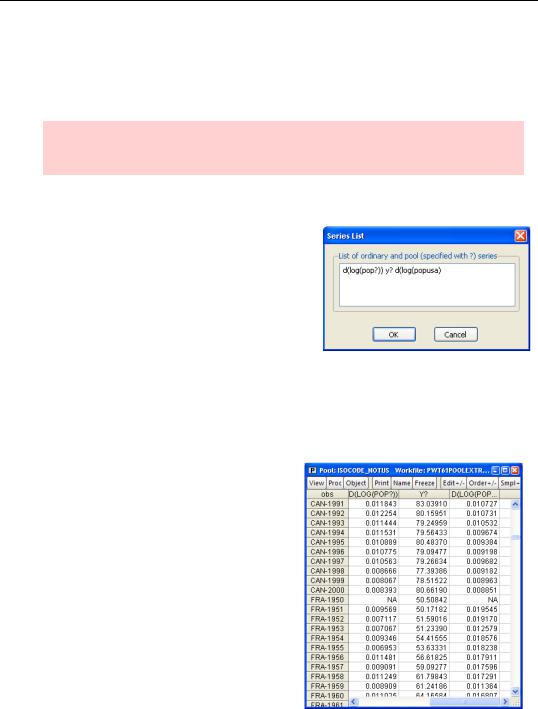
Playing in the Pool—Data—297
Playing in the Pool—Data
Pooled series are just plain-old series that share a naming convention. All the usual operations on series work as expected. But there are some extra features so that you can examine or manipulate all the series in a pool in one operation.
Hint: It’s fine to have multiple pool objects in the workfile. They’re just different lists of identifiers, after all.
Spreadsheet Views
Pools have two special spreadsheet views, stacked and unstacked, chosen by pushing the  button or choosing the View/Spreadsheet (stacked data)… menu. For either view, the first step is to specify the desired series when the Series List dialog opens. Enter the names of the series you’d like to see, using the conventions that a series with a question mark means replace that question mark with each of the country ids
button or choosing the View/Spreadsheet (stacked data)… menu. For either view, the first step is to specify the desired series when the Series List dialog opens. Enter the names of the series you’d like to see, using the conventions that a series with a question mark means replace that question mark with each of the country ids
in turn. A series with no a question mark means use the series as usual, repeated for each country. The way we’ve filled in the dialog here asks EViews to display D(LOG(POPCAN)), D(LOG(POPFRA)), etc., for YCAN, YFRA, etc., and for D(LOG(POPUSA)) separately.
Stacked View
The spreadsheet opens with all the data for Canada followed by all the data for France, etc. The data for POPUSA gets repeated next to each country. Notice how the identifier  in the obs column gives the crosssection identifier followed by the date—in other words, country and year.
in the obs column gives the crosssection identifier followed by the date—in other words, country and year.
This is called the stacked view. You can imagine putting together all the data for Canada, then stacking on all the data for France, etc. We’ll return to the idea of a stacked view when we talk about loading in pooled data below.
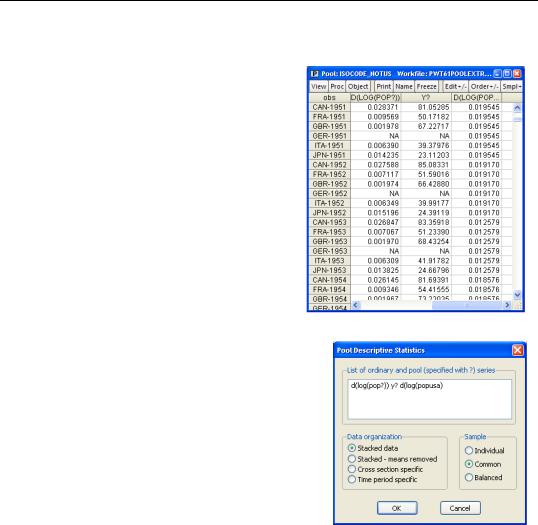
298—Chapter 12. Everyone Into the Pool
Unstacked View
Re-arranging the spreadsheet into the “usual order,” that is by date, is called the unstacked view. Clicking the  button flicks back- and-forth between stacked and unstacked views.
button flicks back- and-forth between stacked and unstacked views.
Pooled Statistics
The Descriptive Statistics… view offers a number of ways to slice and dice the data in the pool. We’ve put two pooled series (with the “?” marks) and one non-pooled series in the dialog so you can see what happens as we try out each option.
First, look at the Sample radio buttons on the right. The presence of missing data, NAs, means that the samples available for one series may differ from the sample available for another. You can see above, for example, that Canada, France, and Great Britain have data starting in 1950, but that German data begins later. Common sample instructs EViews to
use only those observations available for all countries for a particular series, while Balanced sample requires observations for all countries for all series entered in the dialog. Individual sample means to use all the observations available.
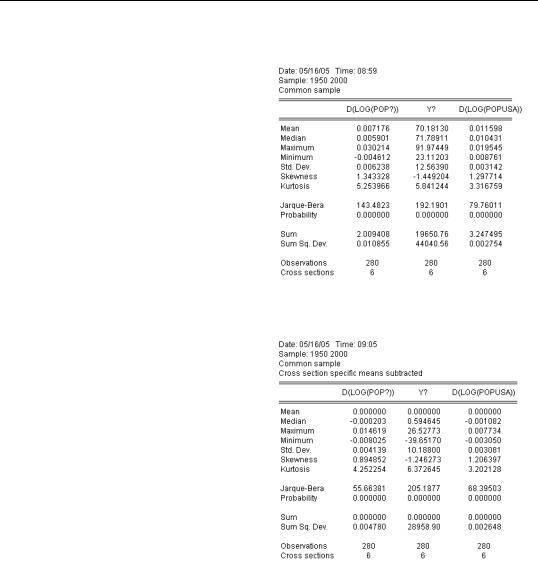
Playing in the Pool—Data—299
Stacked Data Statistics
The default Data Organization is
Stacked data, which stacks the series for all countries together for the purpose of producing descriptive statistics. For example, we see that GDP per capita in our six pooled countries averaged just over 70 percent of U.S. GDP per capita. (Y is measured relative to U.S. GDP.)
Stacked - Means Removed
Specifying Stacked - means removed in Descriptive Statistics produces some pretty funny looking output, but it turns out that this method is just what we want for answering certain questions. EViews subtracts the means for each country before generating the descriptive statistics. As a consequence, the means are always zero, which looks pretty funny.
The raison d’être for Stacked - means removed is to see statistics other than the means and medians. (The medians aren’t zero, but they’re pretty close.)
According to the Stacked data statistics,
the standard deviation of annual U.S. population growth was 3/10ths of one percent, while the standard deviation for the pooled countries was 6/10ths of one percent. This looks like population growth was much more variable for the countries in the pooled sample. Whether this is the correct conclusion depends on a subtle point. Some of the countries have relatively high population growth and some have lower growth. The standard deviation for Stacked data includes the effect of variability across countries and across time, while the standard deviation reported for the United States is looking only at variability across time. The Stacked - means removed report takes out cross-country variability, reporting the time
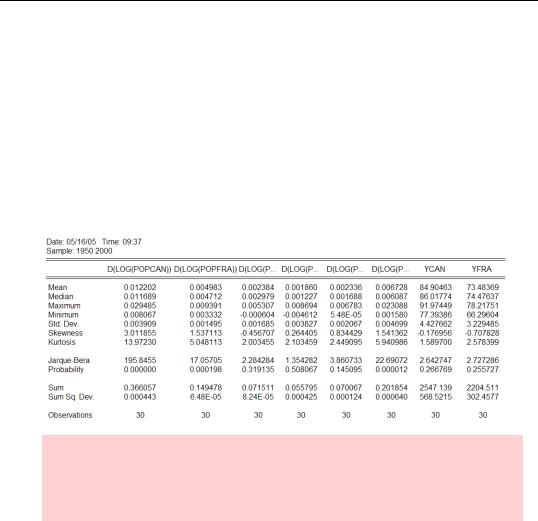
300—Chapter 12. Everyone Into the Pool
series variation within a country, averaged across the pooled sample. This standard deviation is just over 4/10ths of one percent. So the typical country in our pooled sample has only slightly higher variability in population growth than the United States.
The choice to remove means or not before computing descriptive statistics isn’t a right-or- wrong issue. It’s a way of answering different questions.
Cross Section Specific Statistics
Choosing the Cross section specific radio button generates descriptive statistics for each country separately, one column for each country for each series. In our example we have six reports from D(LOG(POP?)), six from Y?, and one from D(LOG(POPUSA)), an excerpt of which is shown below.
Empirical aside: If you’re following along on the computer, you can scroll the output to see that three of the countries in the pooled sample have population growth standard deviations much lower than the U.S. and three have standard deviations a little above that of the U.S.
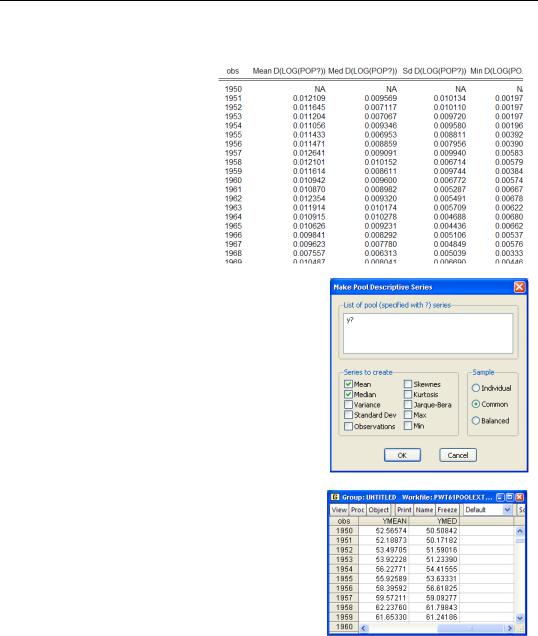
Playing in the Pool—Data—301
Time Period Specific Statistics
Time period specific is the flip side of Cross section specific. Time period specific pools the whole sample together and then computes mean, median, etc., for each date.
You can save the time period
specific statistics into series. Click the  button and choose Make Periods Stats series….
button and choose Make Periods Stats series….
Check boxes for the desired descriptive statistics and EViews will (1) create the requested series, YMEAN, YMED, etc., and (2) open an untitled group displaying the new series.
